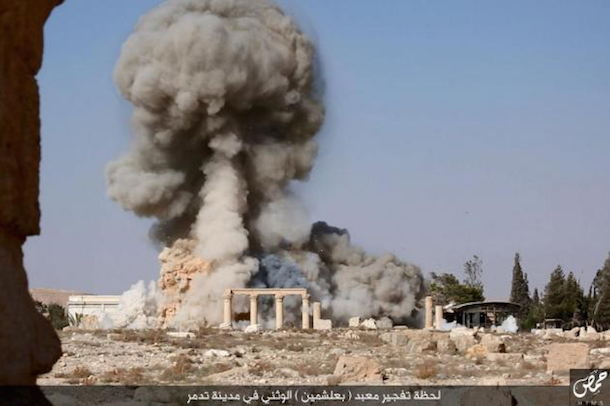
ISIS: The Religious Fallacy Against History
Da’ish or ISIS, is in the news again, only this time for destroying heritage sites. With an active propaganda machinery it has spread fear and chaos and provides a violent form of yellow journalism for the media to consume. Art is vandalized, desecrated without remorse and this act savagely strikes at the very idea of human heritage and it’s preservation of the past and guidance for the present. Recently in Syria’s ancient city of Palmyra ISIS tied three captives to Roman-era columns laden with explosives and detonated them.
While ISIS is known for its regular well-orchestrated killings of captives, this is not the first time they have destroyed historical monuments. Previously, they destroyed relics belonging to the Roman era including the 2,000 year old Arch of Triumph and Temple of Bel. They have also laid siege to the Temple of Baalshamin, a United Nations World Heritage site and destroyed idols kept at Mosul’s museum. These acts have been condemned world over. UNESCO would term such actions as equivalent to a war crime. ISIS has even beheaded the antiquities expert looking after the ruins at Palmyra and ransacked Mosul’s central museum and destroyed statues and relics from the ancient empires of Assyria and Akkadia. They have burned thousands of rare manuscripts and books from the Mosul library. With a campaign against human history ISIS beheaded Khaled Assad, 82, Palmyra’s director of antiquities and the head of its museum. ISIS has bulldozed the site of Nimrud, capital of the 9th-century B.C. Assyrian King Ashurnasirpal II. It also destroyed Nineveh’s Nergal Gate.
Historically Palmyra oasis has been a strategic location and attraction. Now, unfortunately it faces destruction. It was an historical trade route that linked Persia, India and China with the Roman Empire. Due to its prime location and known for its trade route, the city has a plethora of structures of historical significance. It is known as the “Bride of the Desert” for being a vital stopping point for multiple caravans.
Following whose footsteps
As is their penchant for grabbing headlines, they have released videos that show this destruction. The videos released by ISIS have verses of the Quran being recited in the background. They claim to be practicing Islamic iconoclasm. According to ISIS, the theological legitimacy of these acts is derived from basically two events in Islamic history, namely – the mutilation of idols by Abraham and the removal of idols from the Kaaba in Makkah by Prophet Muhammad. However, their rationale has a major fallacy. Firstly, Abraham called an entire nation (Ummah) in the Quran. His representation of a complete society makes his tribulations exclusive to him and not for everyone else to imitate. The circumstances he faced were unique and only limited to him. ISIS falsely associates themselves with Abraham when they claim to be following his legacy. In fact the Prophet and the early Muslims lived in Makkah for 10 years and they did not destroy the idols in the Kaaba. If it were about following legacies who would have been better than Prophet Muhammad, he did not imitate Abraham in destroying idols to make his argument.

The Prophet did remove the idols from the Kaaba. This was after he had in a bloodless coup taken over Makkah and was in connection to the purification of the House of Allah. The Kaaba is located inside a mosque, Al-Masjid al-Haram. Prophet Muhammad was clearing the Kaaba and area around for the sole reason it was going to be a place of worship for Muslims. ISIS, on the other hand, goes out of its way to destroy these idols kept inside museums which is no business of theirs. The Quran does not command the breaking of idols. In fact the Quran makes it clear not to even curse or speak ill of others religious deities. When Abraham broke the idols in his town he was merely making a particular example for a particular town in a specific context, and he was the only one. Besides Abraham, no Prophet in Islamic history went out of his way to break any idols. Moreover, the argument that these statues and monuments promote idolatry falls flat on its face when one could easily figure out that nobody is worshipping these idols in Mosul or Palmyra. They belong to a religion of long ago. There are no active worshippers to pay obeisance to those idols or temples. Even during the legitimate rule of the Rashidun, Umayyad or the Abbasid Caliphate, these structures were not destroyed. The question that arises then is under what authority has ISIS assumed this mantle for destroying heritage sites.
The study of the past defines the future
According to Murtaza Hussain, any conflict or act involving Muslim groups like ISIS is seen as being driven by atavistic religious beliefs. But ISIS is an entity that emerged due to the political vacuum created by disintegration of the ruling power and the US invasion. A deeper examination reveals that it is engaged in damnatio memoriae or the “damnation of memory,” an age old practice of erasing the history, to leave no trace of the person or object condemned. It wishes to erase history just as Stalin and Hitler attempted to erase history. However, the past can never be truly erased.
With misplaced doctrinal sanctions they have engaged in the destruction of these sites. These acts of ISIS are not in the spirit of Islam rather they are providing for their illegal antiquities trade. The destruction of these sites in order to gain access to their archeological riches lays bare their hypocritical and false claim of fulfilling legacies. Their strong opposition to alternate ideas of nation states built on non-Islamic traditions leads to this aberrant behavior. They in fact even deliberately target heritage sites during combat. ISIS wishes to rewrite history and clear off a culture that does not align with their ideology. This systematic cleansing is aimed at disconnecting history and wiping out the cultural diversity of Iraq and Syria. This is an effort to make a rainbow into one shade of their own resulting in the deprivation of the people from their identity and history.
The onus to preserve these sites derives from the idea that the past helps in defining the future. These are records of human history, an element in appreciating the human story. ISIS wishes to destroy diversity and impose its brand of uniformity with a peculiar brand of Islam. A diverse culture with a tolerant past is an anathema to ISIS. With its idea of regional domination, as a ruling government, it is effectively engaged in ethnic and religious cleansing. ISIS believes it cannot control the future unless it takes over the past. It wishes to eradicate all alternate interpretations of Islam; dismissing anything that is alien to its worldview. As Sturt Manning puts it, the best way to eradicate hatred and violence is by teaching communities more about their own and other’s culture and histories.
What lies ahead?
The irony of the fact that the Iraq-Syria region is known as the “Cradle of Civilization.” This region was home to Mesopotamia, one of the world’s first cities and organized governments back in 5000 BC. Now it is home to an illegitimate non-state entity with high accounts of mis-governance. What is required then is for the mainstream media to give space to educated Muslim scholars that would dismiss and provide a religious counter-narrative to the misinterpretation that ISIS relies upon. Additionally, this destruction can be stopped in its tracks by better policing the international antiquities black market. This would stop the economic benefits that they derive from this destruction. As some of the antiquities may well be gone forever, remembering them is the best rebuttal, as memory and knowledge are the major fears of ISIS and these soft factors shall remain and cannot be destroyed.

